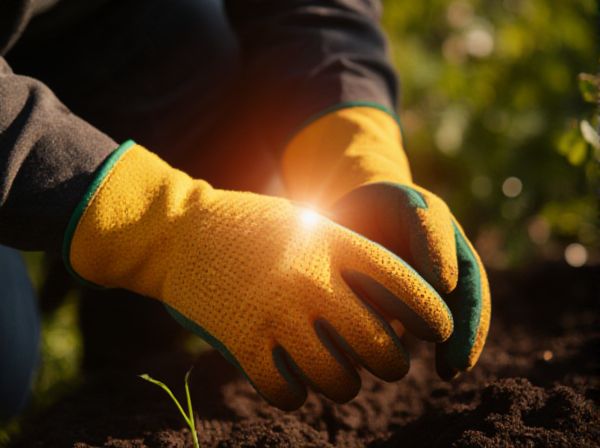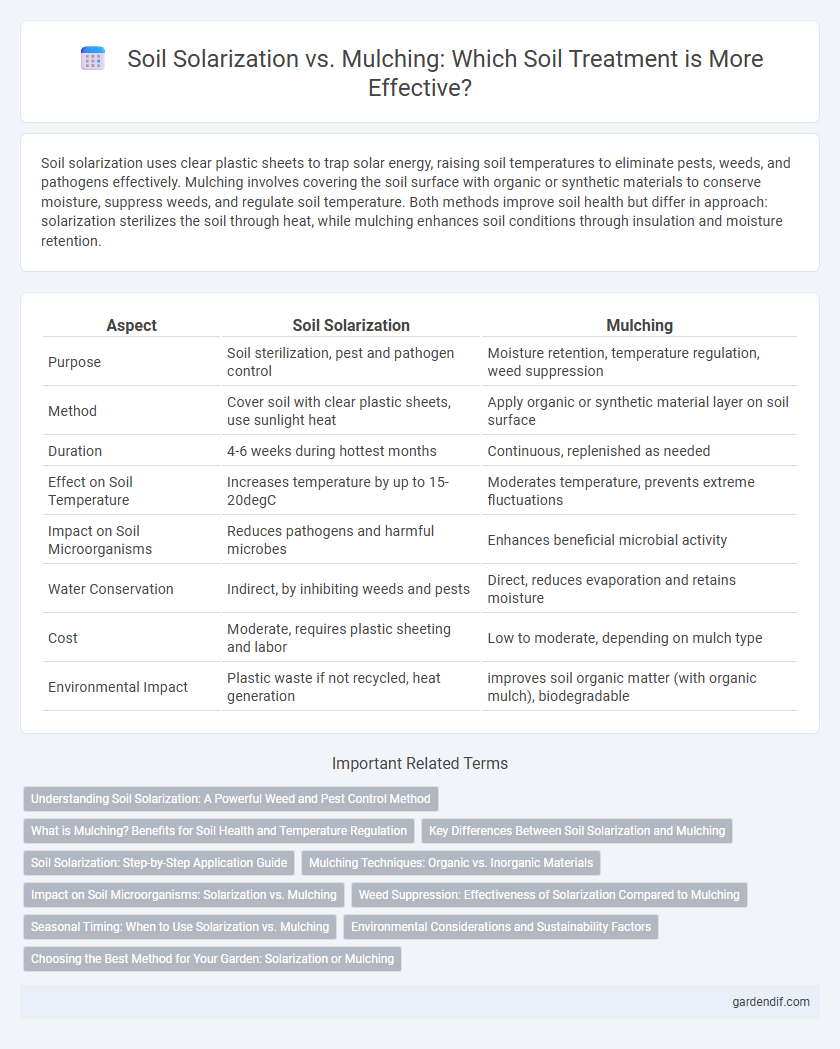
Soil solarization vs Mulching Illustration
Soil solarization uses clear plastic sheets to trap solar energy, raising soil temperatures to eliminate pests, weeds, and pathogens effectively. Mulching involves covering the soil surface with organic or synthetic materials to conserve moisture, suppress weeds, and regulate soil temperature. Both methods improve soil health but differ in approach: solarization sterilizes the soil through heat, while mulching enhances soil conditions through insulation and moisture retention.
Table of Comparison
| Aspect | Soil Solarization | Mulching |
|---|---|---|
| Purpose | Soil sterilization, pest and pathogen control | Moisture retention, temperature regulation, weed suppression |
| Method | Cover soil with clear plastic sheets, use sunlight heat | Apply organic or synthetic material layer on soil surface |
| Duration | 4-6 weeks during hottest months | Continuous, replenished as needed |
| Effect on Soil Temperature | Increases temperature by up to 15-20degC | Moderates temperature, prevents extreme fluctuations |
| Impact on Soil Microorganisms | Reduces pathogens and harmful microbes | Enhances beneficial microbial activity |
| Water Conservation | Indirect, by inhibiting weeds and pests | Direct, reduces evaporation and retains moisture |
| Cost | Moderate, requires plastic sheeting and labor | Low to moderate, depending on mulch type |
| Environmental Impact | Plastic waste if not recycled, heat generation | improves soil organic matter (with organic mulch), biodegradable |
Understanding Soil Solarization: A Powerful Weed and Pest Control Method
Soil solarization is a method that uses solar energy to heat the soil to temperatures lethal for weeds, pests, and pathogens by covering moist soil with transparent plastic during peak sunlight months. This technique increases soil temperature to around 45-60degC (113-140degF), effectively sterilizing the soil and reducing the need for chemical pesticides. Compared to mulching, which primarily conserves moisture and suppresses weeds through organic or plastic layers, soil solarization offers a powerful and eco-friendly pest control solution by directly eliminating harmful soil organisms.
What is Mulching? Benefits for Soil Health and Temperature Regulation
Mulching involves covering the soil surface with organic or inorganic materials to conserve moisture, suppress weeds, and regulate soil temperature. This practice enhances soil health by improving moisture retention, promoting beneficial microbial activity, and preventing soil erosion. Mulching also stabilizes soil temperature, reducing heat stress during hot weather and protecting roots from extreme cold.
Key Differences Between Soil Solarization and Mulching
Soil solarization uses clear plastic sheets to trap solar energy, increasing soil temperature to eliminate pathogens, weeds, and pests, whereas mulching involves covering soil with organic or inorganic materials to conserve moisture and suppress weeds. Solarization requires several weeks of intense sun exposure for effective sterilization, while mulching provides ongoing protection and nutrient retention without heat treatment. The key difference lies in soil solarization's focus on pest control through thermal treatment, contrasting with mulching's role in moisture conservation and soil health improvement.
Soil Solarization: Step-by-Step Application Guide
Soil solarization involves covering moist soil with clear plastic sheets to trap solar energy, raising soil temperatures to 45-60degC for 4 to 6 weeks, effectively eliminating soil-borne pathogens, weeds, and nematodes. The process requires adequate soil moisture, thorough soil preparation including tilling and leveling, and secure placement of transparent polyethylene films during the hottest months to maximize heat retention. This method improves soil health by reducing disease pressure and enhancing nutrient availability without introducing chemicals.
Mulching Techniques: Organic vs. Inorganic Materials
Mulching techniques use either organic materials like straw, wood chips, and compost or inorganic materials such as plastic sheeting and rubber mats to improve soil health and moisture retention. Organic mulches decompose over time, enriching soil structure and nutrient content, whereas inorganic mulches primarily control temperature and suppress weeds without altering soil chemistry. Choosing between organic and inorganic mulches depends on crop needs, environmental conditions, and long-term soil management goals.
Impact on Soil Microorganisms: Solarization vs. Mulching
Soil solarization uses solar heat to significantly reduce soil pathogens and weed seeds by raising soil temperatures to lethal levels, which often leads to a temporary decline in beneficial soil microorganisms. Mulching preserves soil moisture and temperature, creating a stable environment that supports diverse microbial communities and enhances soil organic matter decomposition. The impact on soil microorganisms varies as solarization disrupts microbial ecosystems through intense heat, while mulching fosters microbial activity by providing organic substrates and protecting soil from erosion.
Weed Suppression: Effectiveness of Solarization Compared to Mulching
Soil solarization uses high soil temperatures to kill weed seeds and pathogens, providing effective weed suppression for several months after treatment. Mulching suppresses weeds by blocking sunlight and physically preventing seed germination but may allow some shallow-rooted or wind-dispersed weeds to emerge. Solarization generally offers more long-term weed control, while mulching provides immediate but less durable suppression.
Seasonal Timing: When to Use Solarization vs. Mulching
Soil solarization is most effective during the hottest months, typically late spring to mid-summer, when intense sunlight and high temperatures can sterilize soil pathogens. Mulching is versatile across seasons, providing moisture retention, temperature regulation, and weed suppression from spring through fall. Choosing between solarization and mulching depends on seasonal climate, with solarization targeting pest control in peak heat, while mulching supports soil health and moisture during growing periods.
Environmental Considerations and Sustainability Factors
Soil solarization uses clear plastic sheets to trap solar energy, effectively reducing soil pathogens but may generate plastic waste posing environmental challenges. Mulching utilizes organic materials like straw or wood chips that enrich soil fertility and promote moisture retention while minimizing erosion and reducing the carbon footprint. Sustainable soil management favors mulching due to its biodegradability and enhancement of soil biodiversity, making it an eco-friendly alternative to plastic-intensive solarization methods.
Choosing the Best Method for Your Garden: Solarization or Mulching
Soil solarization, utilizing clear plastic to trap solar energy, effectively reduces soil-borne pathogens and weeds by raising soil temperature, making it ideal for preparing soil in warm climates. Mulching, involving organic or inorganic layers spread over the soil surface, conserves moisture, improves soil structure, and suppresses weed growth, suitable for maintaining soil health throughout the growing season. Selecting between soil solarization and mulching depends on specific garden goals, soil conditions, and climate, with solarization favored for pest control and mulching preferred for ongoing soil protection and moisture retention.
Soil solarization vs Mulching Infographic

 gardendif.com
gardendif.com